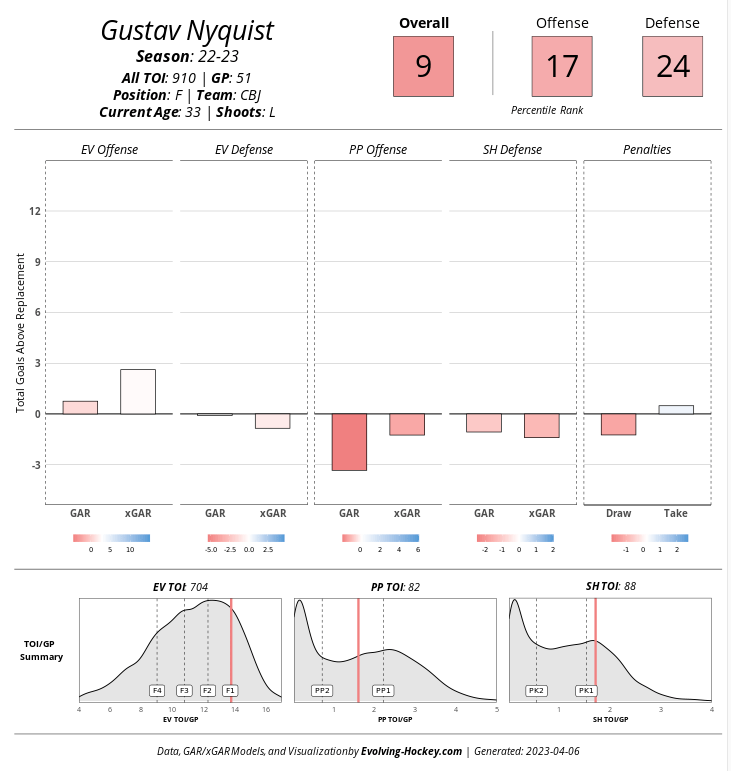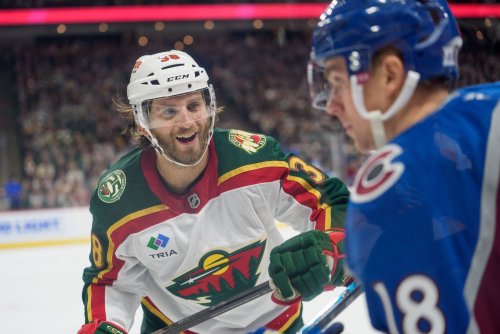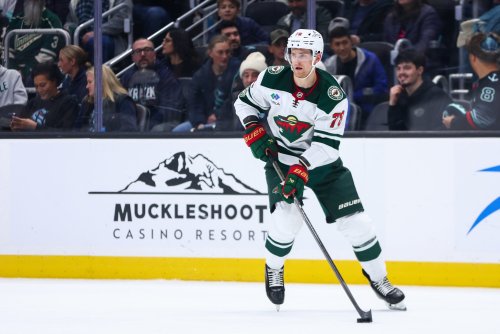
The Trade Deadline Acquisition is nearing his Wild debut, but where does he fit and what does he bring?
If you’re a big practice-head, you already know the news from yesterday’s Minnesota Wild practice. Folks, he’s back!
If you were having a bad day now you’re not 🤝 #mnwild pic.twitter.com/yquoWEPG4p
— x - Minnesota Wild (@mnwild) April 5, 2023
That’s right, in the background wearing a yellow “No-Contact” jersey, you can see Gustav Nyquist, the veteran winger the Minnesota Wild traded for at last month’s deadline.
Nyquist was on the shelf with injury when the Wild traded a fifth-round pick for him, and hasn’t played an NHL game since January 25. It wasn’t even certain that he’d be ready to go for the postseason at the time of the trade, so it’s good news for Minnesota that their flier on the Swedish forward may pay off soon.
A long-time productive veteran with 174 goals and 423 career points coming into the lineup is a good ace up a team’s sleeve. Furthermore, despite having 61 fewer career goals and 190 fewer career points, Kirill Kaprizov donning that same yellow jersey also carried some buzz around the State of Hockey. Hopefully, he can also bring some scoring in his return to the lineup.
I kid. Wild fans don’t need to hear about what Kaprizov can do in Minnesota. But what about Nyquist? It was easy to sleep on him with his playoff readiness in doubt, and the additions of Marcus Johansson, John Klingberg, and Oskar Sundqvist. Now that Nyquist is entering the chat, let’s take a closer look at what he gives Minnesota.
At first glance, it doesn’t look like much at all. At 5-on-5 this season, opponents out-scored Nyquist 33-24 on the season, leaving Nyquist with a measly 42.1% of the goal share. His expected goals suggest he’s been unlucky, but not by that much. At 44.4%, we’re looking at a nightmare-type season.

It’s a big yikes, but we’ve got to look at extenuating circumstances. A big one is, those numbers are pretty much par for the course for the Columbus Blue Jackets. In fact, they’re above average. Columbus gets just 38.7% of the goals share at 5-on-5, as well as 43.3% of the expected goals share. For a team that’s only tied for first in the Connor Bedard sweepstakes (assuming no rigging, which, let’s admit, is a pipe dream for Columbus), that’s not exactly surprising.
But what stands out about Nyquist’s season up until his injury was that he still was average-ish at doing things to generate offense. And for the Wild, average-ish is going to help after struggling all season.

He’s slightly above average at generating both shots and shot assists, according to Corey Sznajder’s All Three Zones tracking project. You can’t really say about well, most anyone else on the Wild. According to Sznajder’s tracking data, the only players on the roster who are above-average at both shooting and shot assists are Kaprizov, Matt Boldy, and Johansson (albeit, in a five-game sample).
That’s been Nyquist’s deal for this season: He gives you a little bit of everything, and does it a bit better than the league average. Nyquist rates just fine at entering the offensive zone, exiting his own zone, and setting up scoring chances. He’s a useful player.
That is, unless you’re talking about the power play and defense. But again, look at what he’s had to work with. The best center he’s had over the last two seasons is Jack Roslovic. Maybe we can cut him some slack over that.
It’s not just the raw stats that make him a fit. He also solves a major problem that’s plagued Minnesota all season: generating offense on the rush. Let’s look at how he stacks up against the rest of the Wild.

You see that there are Wild players who have generated shots on the rush this year… but the issue is, a bunch of them aren’t around anymore. Jordan Greenway and Tyson Jost are both in Buffalo. That leaves Kaprizov, Johansson, Boldy, and Ryan Hartman as the only players who are above-average at creating off the rush.
Spent a moment connecting the dots, and you notice something: Those guys are all on two lines. There’s virtually no rush creation on the lower lines. Look back at those above-average shot contributors, and you won’t see much in the Wild’s Bottom-6, either.
Minnesota doesn’t have room for Nyquist in the Top-6. Zuccarello is firmly planted as Kaprizov’s running mate, and Johansson’s transition game is supplementing Boldy and Joel Eriksson Ek. Maybe it’s weird to have a winger like Nyquist, an offensive player who historically plays on the first or second-line, down in the lineup, but it could work.
Secondary scoring is a big reason for Minnesota’s struggles all throughout the year, and the biggest reason for their resurgence in the wake of Kaprizov’s injury. Nyquist gives them another option for their Bottom-6, but even more importantly, a level of dynamism that might be mediocre on a higher line, but is going to stand out in a checking-line role.
Unfortunately, there’s a spot for a third-liner to move down in the lineup in the wake of Mason Shaw‘s horrible, devastating injury. Someone like Sundqvist, or Marcus Foligno, or Freddy Gaudreau, or really, anyone else, can slide down and fortify that spot.
Options are good, and having Nyquist in the back gives the Wild another look for when they jump into the postseason. He also serves as a credible, proven veteran scorer who can slide up the lineup in case, say, Zuccarello or Johansson find themselves injured or ineffective. Either is nice to have with the playoffs just five games away.
This article was originally published on April 6, 2023. All data via Evolving Hockey unless otherwise stated.
Think you could write a story like this? Hockey Wilderness wants you to develop your voice, find an audience, and we'll pay you to do it. Just fill out this form.








Recommended Comments
Join the conversation
You can post now and register later. If you have an account, sign in now to post with your account.
Note: Your post will require moderator approval before it will be visible.